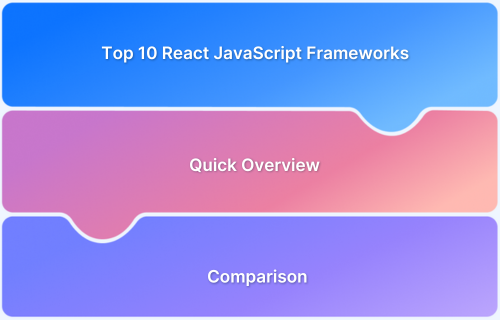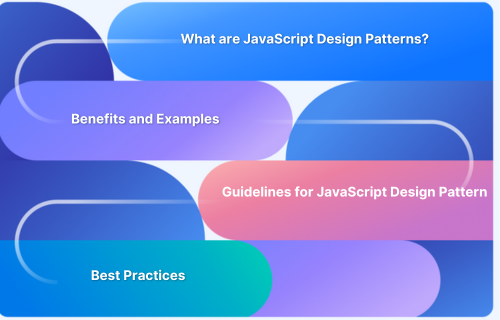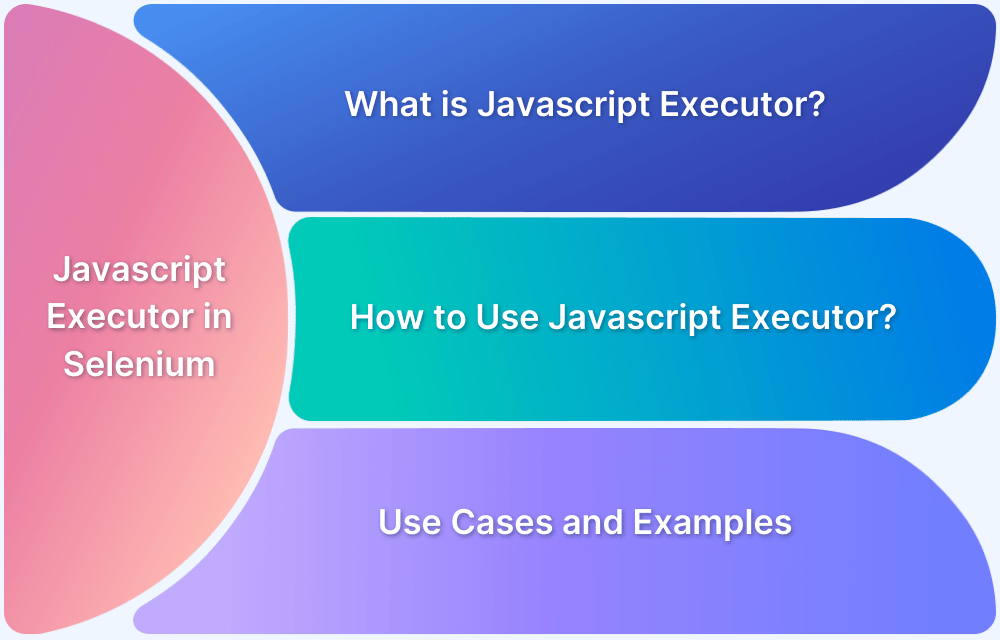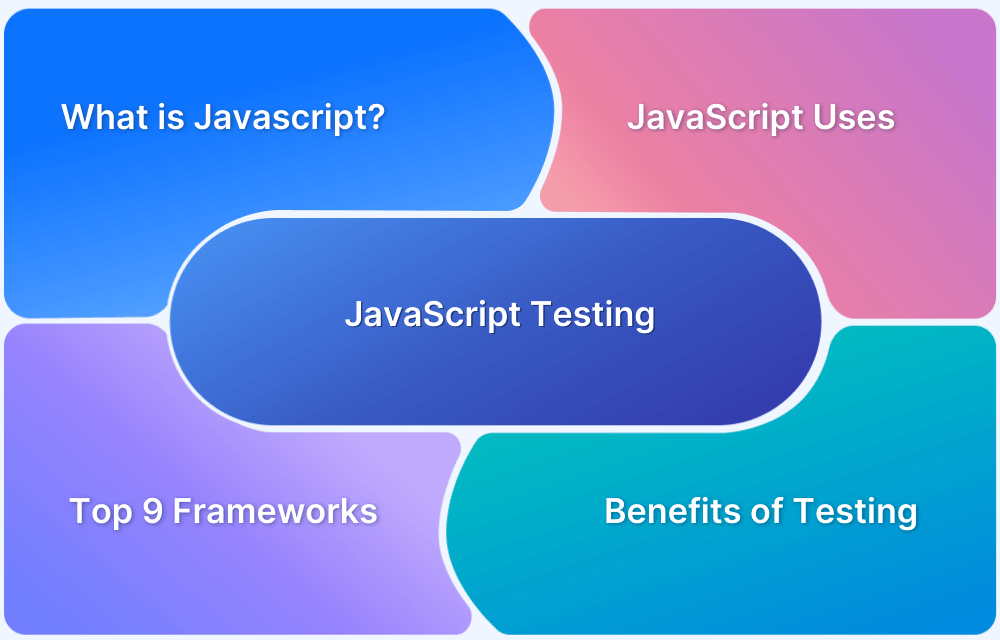React (or React.js) is one of the most popular frontend JavaScript libraries, developed by Facebook (now Meta) that helps developers build interactive and dynamic user interfaces.
Overview
React JavaScript frameworks extend React’s core capabilities, enabling developers to build efficient, scalable, and optimized web and mobile applications.
Top React JavaScript Frameworks
- Next.js: A powerful framework for server-side rendering (SSR) and static site generation (SSG), improving performance and SEO.
- Gatsby: A static site generator optimized for speed and performance, using GraphQL for data management.
- Remix: Focuses on progressive enhancement, with built-in SSR and seamless handling of nested routes.
- RedwoodJS: A full-stack React framework integrating GraphQL and Prisma for rapid development.
- React Router: The standard library for routing in React applications, providing dynamic and declarative navigation.
- Razzle: A universal JavaScript framework that enables SSR without configuration complexity.
- Next.js + TypeScript: Combines Next.js with TypeScript for robust type safety and scalable application development.
- Expo for React: A framework for building React Native applications with easy deployment and cross-platform support.
- Blitz.js: A full-stack framework inspired by Ruby on Rails, providing an end-to-end development experience.
- React Bootstrap: A front-end UI library that brings Bootstrap components to React for responsive and modern designs.
This article explores React JavaScript frameworks, highlighting the top 10 frameworks to use in 2025, and provides a comparison to help identify the best option for various projects.
What is a React JavaScript Framework?
React JavaScript framework is a collection of tools and libraries built on React.js to enhance its functionality and simplify development.
While React.js is a UI library focused on building reusable components, frameworks like Next.js, Gatsby, and Remix extend their capabilities by adding features like server-side rendering (SSR), static site generation (SSG), routing, and state management.
These frameworks help developers build scalable, high-performance applications with better SEO and faster page loads.
Key Features of React JavaScript Frameworks:
- Built-in Routing: Most frameworks offer a structured way to handle navigation between pages without manually setting up React Router.
- Server-Side Rendering (SSR): Generates pages on the server that improves SEO and performance.
- Static Site Generation (SSG): Pre-renders pages at build time for faster load speeds.
- Automatic Code Splitting: Loads only the necessary JavaScript that can help reduce initial page load times.
- Simplified State Management: Some frameworks integrate seamlessly with state management tools like Redux, Recoil, or built-in APIs.
A Quick Overview of the Top React JavaScript Frameworks
Here’s a quick overview of some of the most popular React JavaScript frameworks:
| Framework | Description | Key Features | Use Cases |
|---|---|---|---|
| Next.js | It is a server-side rendering framework for React. Offers SSR and SSG. | SSR, SSG, Vercel Integration, SEO-friendly, flexible rendering strategies | Dynamic web apps, hybrid apps, progressive web apps |
| Gatsby | It is a static site generator with performance optimizations. | SSG, Performance optimizations, PWA capabilities, GraphQL integration | Content-heavy sites, blogs, static websites |
| Remix | It is a full-stack framework focusing on routing and server-side rendering. | Advanced routing, SSR, robust user experience, server-side rendering | Complex web applications, full-stack development |
| RedwoodJS | It is a full-stack framework with built-in support for GraphQL and serverless. | GraphQL, serverless, full-stack development, robust routing | Complex web applications, serverless architecture |
| React Router | It is a library for client-side routing in React applications. | Client-side routing, easy integration with React | Single-page applications, client-side routing |
| Razzle | It is a server-side rendering framework similar to Next.js but with more flexibility. | SSR, flexible configuration, serverless support | Dynamic web apps, serverless architecture |
| Next.js + TypeScript | It is a combination of Next.js with TypeScript for enhanced type safety. | Type safety, Next.js features, improved code maintainability | Large-scale applications, enterprise environments |
| Expo for React | It is a framework for building cross-platform mobile apps with React. | Cross-platform, mobile app development, ease of use | Mobile app development, cross-platform support |
| Blitz.js | Full-stack React framework built on Next.js with a zero-API data layer. | Zero-API data layer, monolithic architecture, database agnostic, TypeScript support | Full-stack web applications, rapid development |
| React Bootstrap | It is a UI kit that combines Bootstrap with React for accessible components. | Accessible components, responsive design, theming support | UI development, accessible web applications |
Top 10 React JavaScript Frameworks to Use in 2025
Picking the right React.js framework can make development easier, boost SEO, and create a smoother user experience.
To help you choose, here’s a list of the top 10 React frameworks to use in 2025, along with their features and installation steps:
1. Next.js:
Next.js is a powerful React framework developed by Vercel that makes building fast and SEO-friendly web applications easy. It supports server-side rendering (SSR) and static site generation (SSG), which improves page load speed and search engine rankings.
Next.js also comes with built-in routing, image optimization, and API handling, making it an excellent choice for developing production-ready applications with minimal configuration.
Features:
- Server-Side Rendering (SSR) & Static Site Generation (SSG) for better SEO
- Automatic code splitting for improved performance
- API routes to build backend logic within the same project
- Image optimization for faster loading
- TypeScript support for safer development
Installation:
- Open your terminal and run:
npx create-next-app@latest my-next-app
This command creates a new Next.js project.
- Navigate to the project folder:
cd my-next-app
- Start the development server:
npm run devNow, your Next.js app is running on http://localhost:3000.
2. Gatsby
Gatsby is a static site generator that makes web pages fast by preloading them. It is great for blogs, marketing websites, and content-heavy platforms. Gatsby uses GraphQL to fetch data efficiently and has a huge ecosystem of plugins for extra functionality.
Features:
- Static Site Generation (SSG) for ultra-fast page loads
- GraphQL integration for optimized data fetching
- Rich plugin ecosystem to extend functionality
- SEO-friendly with pre-built pages
- Supports Markdown for easy content creation
Installation:
- Install Gatsby CLI globally by running:
npm install -g gatsby-cli
- Create a new Gatsby project:
gatsby new my-gatsby-site
- Navigate to your project folder:
cd my-gatsby-site
- Start the development server:
npm run developYour Gatsby site is now running on http://localhost:8000.
3. Remix
It is a modern React framework focused on performance and progressive enhancement. Remix provides server-side rendering (SSR) and handles data loading in a way that makes applications smoother and faster.
Features:
- Server-side rendering (SSR) for better SEO and performance
- Optimized data loading for a seamless user experience
- Nested routing for better project organization
- Supports progressive enhancement for accessibility
Installation:
- Create a new Remix project by running:
npx create-remix@latest my-remix-app
- Navigate to the project folder:
cd my-remix-app
- Start the development server:
npm run devNow, your Remix app is running on http://localhost:3000.
4. RedwoodJS
It is a full-stack React framework that combines React on the front end and GraphQL on the back end. It is built for startups and scalable applications, making it easy to develop modern web apps with authentication and database management.
Features
- Full-stack framework with built-in backend support
- GraphQL integration for efficient data fetching
- Serverless-friendly architecture
- Built-in authentication for user management
Installation
- Create a new RedwoodJS app by running:
npx create-redwood-app my-redwood-app
- Navigate to the project folder:
cd my-redwood-app
- Start the Redwood development server:
yarn redwood devYour app will now run locally.
5. React Router
This one is a lightweight routing library that helps developers build single-page applications (SPAs) with dynamic navigation. It supports nested routes, URL parameters, and lazy loading, making it great for modern React apps.
Features:
- Client-side routing for seamless navigation
- Nested routes for structured page layouts
- Dynamic routing with URL parameters
- Lazy loading support for improved performance
Installation:
- Install React Router in an existing React project:
npm install react-router-dom
- Import and configure routing in App.js:
import { BrowserRouter, Routes, Route } from "react-router-dom"; import Home from "./Home"; import About from "./About"; function App() { return ( <BrowserRouter> <Routes> <Route path="/" element={<Home />} /> <Route path="/about" element={<About />} /> </Routes> </BrowserRouter> ); } export default App;
Now, your app will support client-side navigation.
6. Razzle
Razzle is a universal JavaScript framework that simplifies building server-side rendered (SSR) React applications. Unlike Next.js, which has file-based routing, Razzle provides a more flexible approach while maintaining a great developer experience.
It works with React, Preact, Vue, and even Svelte, making it a versatile choice for SSR projects.
Features:
- Universal rendering (SSR & CSR support)
- Zero-config setup to start coding immediately
- Works with multiple frontend frameworks
- Customizable with Webpack and Babel
- Supports TypeScript out of the box
Installation:
- Create a new Razzle project by running:
npx create-razzle-app my-razzle-app
- Navigate to the project folder:
cd my-razzle-app
- Start the development server:
npm startNow your Razzle app is running on http://localhost:3000.
Read More: Angular vs React vs Vue: Core Differences
7. Next.js + TypeScript
Next.js fully supports TypeScript, allowing developers to build safer, more scalable applications with static typing. Using TypeScript with Next.js reduces runtime errors and improves code maintainability, making it a preferred choice for large-scale projects.
Features:
- Full TypeScript support with static typing
- Automatic type checking to catch errors early
- Better scalability for large applications
- Improved developer experience with IntelliSense
- Seamless integration with Next.js features like SSR & SSG
Installation:
- Create a new Next.js project with TypeScript by running:
npx create-next-app@latest my-next-ts-app --typescript
- Navigate to the project folder:
cd my-next-ts-app
- Start the development server:
npm run devYour Next.js + TypeScript app is now live.
8. Expo for React
Expo is a framework for building React Native apps that run on iOS, Android, and the web. It simplifies React Native development by eliminating complex configurations and provides prebuilt APIs for cameras, push notifications, location, and more.
Features:
- Zero-config setup for quick development
- Cross-platform support (iOS, Android, Web)
- Prebuilt APIs for device features (camera, GPS, etc.)
- Over-the-air updates for app deployment
- Live reloading for a smooth development experience
Installation:
- Install Expo CLI globally by running:
npm install -g expo-cli
- Create a new Expo project:
npx create-expo-app my-expo-app
- Navigate to the project folder:
cd my-expo-app
- Start the Expo development server:
npm startNow, scan the QR code in the Expo Go app to see your app live on the mobile device.
9. Blitz.js
Blitz.js is a full-stack React framework built on Next.js. It is designed to make web development faster and easier. Inspired by Ruby on Rails, it provides a zero-API data layer, which enables developers to call backend functions directly from the front end without managing API endpoints.
Blitz.js comes with built-in authentication, database integration, and a great developer experience, making it ideal for building scalable web applications.
Features:
- Comes with ready-to-use authentication and session management
Supports both frontend and backend development in a single framework
Uses Next.js features like server-side rendering and static generation
Provides a simple setup, TypeScript support, and powerful CLI tools
Installation:
- Install Blitz CLI globally by running:
npm install -g blitz
- Create a new Blitz.js project:
blitz new my-blitz-app
- Navigate to the project folder:
cd my-blitz-app
- Start the development server:
blitz devVisit http://localhost:3000 to see your Blitz.js app running.
10. React Bootstrap
React Bootstrap combines Bootstrap components with React. It allows developers to use pre-styled UI elements while maintaining complete control over the component structure.
Features:
- Pre-built UI components based on Bootstrap
- No jQuery is required, making it React-friendly
- Fully responsive design for mobile-first development
- Theming support to customize styles easily
- Compatible with other CSS frameworks
Installation:
- Install React Bootstrap in your project:
npm install react-bootstrap bootstrap
- Import Bootstrap styles in index.js or App.js:
import 'bootstrap/dist/css/bootstrap.min.css';
- Use Bootstrap components in your React project:
import { Button } from 'react-bootstrap'; function App() { return <Button variant="primary">Click Me</Button>; } export default App;
Now, you have Bootstrap-powered components in your React app.
Top React JavaScript Frameworks: A Quick Comparison
Here’s a quick comparison of top React JavaScript frameworks:
| Framework | SSR/SSG Support | Mobile Support | Initial Release | Learning Curve | Best Use Case |
|---|---|---|---|---|---|
| Next.js | Yes | No | 2016 | Moderate | Scalable web apps, SEO-friendly sites |
| Gatsby | Yes (SSG) | No | 2015 | Moderate | Static websites, blogs, content-heavy sites |
| Remix | Yes (SSR) | No | 2021 | Moderate | High-performance web apps with real-time data |
| RedwoodJS | Yes | No | 2022 | Steep | JAMstack applications, startups |
| React Router | No | No | 2014 | Easy | Client-side routing for SPAs |
| Razzle | Yes (SSR) | No | 2017 | Moderate | Universal React apps without Next.js |
| Next.js + TypeScript | Yes | No | 2016 | Moderate | TypeScript-based React projects |
| Expo for React | No | Yes | 2024 | Easy | Mobile apps (iOS, Android, web) |
| Blitz.js | Yes | No | 2020 | Steep | Rapid full-stack app development |
| React Bootstrap | No | Yes | 2019 | Easy | Responsive UI with Bootstrap |
Read More: Getting Started with Selenium and React
Ensure Cross-Browser Compatibility with BrowserStack
While React frameworks like Next.js and Remix offer server-side rendering and performance optimizations, ensuring a bug-free user experience across browsers is critical. Tools like BrowserStack allow developers to test their React applications on real devices and browsers, catching compatibility issues before they reach users.
React frameworks prioritize fast builds and hot module replacement, but performance regressions can still occur. BrowserStack’s Percy enables automated visual testing, allowing teams to detect unintended UI changes across React components after each update.
Additionally, BrowserStack lets developers run real-time interactive tests on iOS and Android devices, ensuring their React apps provide a seamless mobile experience
Conclusion
React JavaScript frameworks offer various features, such as server-side rendering with Next.js, static site generation with Gatsby, and full-stack development with RedwoodJS. Selecting the right framework depends on project goals, scalability needs, and performance expectations.
However, beyond choosing a framework, ensuring seamless functionality across different browsers and devices is equally essential.
BrowserStack provides a comprehensive testing environment with cross-browser and cross-device testing, allowing developers to validate React applications on real devices. It works with Selenium, Playwright, Cypress, and other popular testing tools, ensuring compatibility with existing workflows.
Percy’s visual testing capabilities help catch UI inconsistencies, while parallel testing accelerates execution, reducing development time. Additionally, testing under real user conditions, including different network speeds and device configurations, ensures reliable performance across all platforms.
With BrowserStack, developers can confidently build, test, and deploy high-quality React applications that deliver a flawless experience for every user.





